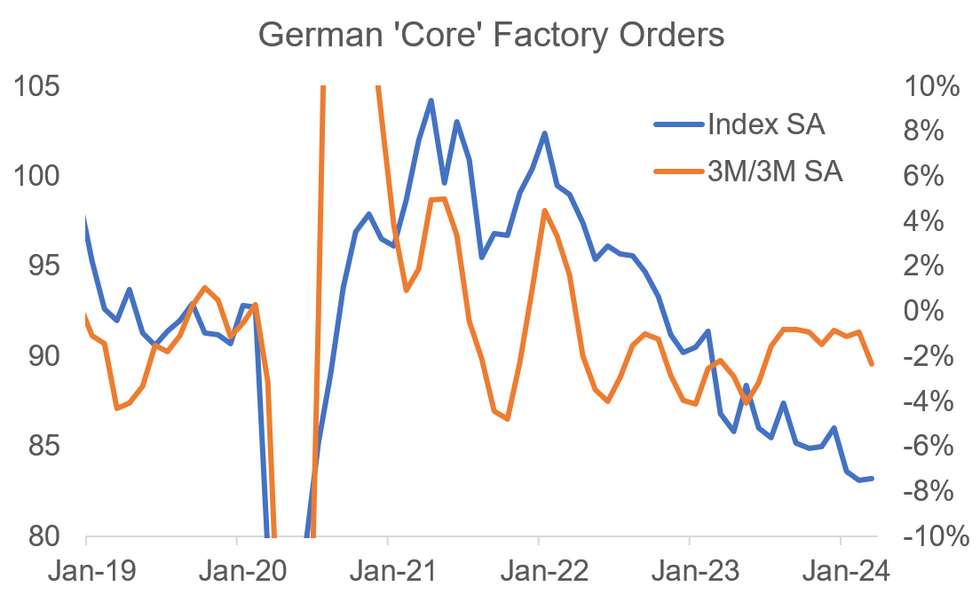-
Policy
Policy
Exclusive interviews with leading policymakers that convey the true policy message that impacts markets.
LATEST FROM POLICY: -
EM Policy
EM Policy
Exclusive interviews with leading policymakers that convey the true policy message that impacts markets.
LATEST FROM EM POLICY: -
G10 Markets
G10 Markets
Real-time insight on key fixed income and fx markets.
Launch MNI PodcastsFixed IncomeFI Markets AnalysisCentral Bank PreviewsFI PiFixed Income Technical AnalysisUS$ Credit Supply PipelineGilt Week AheadGlobal IssuanceEurozoneUKUSDeep DiveGlobal Issuance CalendarsEZ/UK Bond Auction CalendarEZ/UK T-bill Auction CalendarUS Treasury Auction CalendarPolitical RiskMNI Political Risk AnalysisMNI Political Risk - US Daily BriefMNI Political Risk - The week AheadElection Previews -
Emerging Markets
Emerging Markets
Real-time insight of emerging markets in CEMEA, Asia and LatAm region
-
Commodities
-
Credit
Credit
Real time insight of credit markets
-
Data
-
Global Macro
Global Macro
Actionable insight on monetary policy, balance sheet and inflation with focus on global issuance. Analysis on key political risk impacting the global markets.
Global MacroDM Central Bank PreviewsDM Central Bank ReviewsEM Central Bank PreviewsEM Central Bank ReviewsBalance Sheet AnalysisData AnalysisEurozone DataUK DataUS DataAPAC DataInflation InsightEmployment InsightGlobal IssuanceEurozoneUKUSDeep DiveGlobal Issuance Calendars EZ/UK Bond Auction Calendar EZ/UK T-bill Auction Calendar US Treasury Auction Calendar Global Macro Weekly -
About Us
To read the full story
Sign up now for free trial access to this content.
Please enter your details below.
Why MNI
MNI is the leading provider
of intelligence and analysis on the Global Fixed Income, Foreign Exchange and Energy markets. We use an innovative combination of real-time analysis, deep fundamental research and journalism to provide unique and actionable insights for traders and investors. Our "All signal, no noise" approach drives an intelligence service that is succinct and timely, which is highly regarded by our time constrained client base.Our Head Office is in London with offices in Chicago, Washington and Beijing, as well as an on the ground presence in other major financial centres across the world.
Real-time Actionable Insight
Get the latest on Central Bank Policy and FX & FI Markets to help inform both your strategic and tactical decision-making.
Free AccessWeak Domestic Demand Drives Factory Orders Drop, But 'Core' Stable
German factory orders fell by 0.4% M/M in March, softer than the +0.4% expected and an even bigger downside miss when considering a downward revision in February (by 1.0pp to -0.8% - all figures are real, SWDA). The underlying 'core' measure pointed towards some stabilisation, however.
- Factory orders fell 1.9% Y/Y (vs -0.7% consensus) vs -8.8% in February, with the improvement in the annual comparison mainly due to base effects.
- Core (ex-large ticket items) orders, a better measure of underlying activity, increased by 0.1% in March (vs -0.6% prior); its less volatile 3M/3M measure printed weaker than before, though, at -2.3% (vs -0.9% prior).
- The breakdown showed the slight 'core' rise was driven by foreign orders (+2.0% M/M vs -1.8% prior, the fastest growth in 4 months), with similar growth in both the Eurozone and non-EZ regions). In contrast, domestic orders decreased by 2.5% (vs +1.0% prior).
- From a category-by-category perspective, core orders rose in all main groups except intermediate goods, with durable goods a notable area of strength (+2.4% M/M vs +3.5% prior after a very weak Jan/Dec).
- Real manufacturing turnover meanwhile declined 0.7% M/M in March (1.1% prior, downwardly revised 1.1pp), adding to evidence that data released Wednesday will show industrial production ended its recent 2-month in March (-0.7% cons vs +2.1% prior).
- Overall, even though core orders are stabilising, the data looks weak compared with other recent German economic prints and soft domestic orders continue to point to an export-led rather than domestic-demand fuelled recovery. Looking ahead, while the key surveys (PMI and IFO) both suggested that manufacturing activity improved in April, they also both remained in contractionary territory.
 MNI, Destatis
MNI, Destatis
To read the full story
Sign up now for free trial access to this content.
Please enter your details below.
Why MNI
MNI is the leading provider
of intelligence and analysis on the Global Fixed Income, Foreign Exchange and Energy markets. We use an innovative combination of real-time analysis, deep fundamental research and journalism to provide unique and actionable insights for traders and investors. Our "All signal, no noise" approach drives an intelligence service that is succinct and timely, which is highly regarded by our time constrained client base.Our Head Office is in London with offices in Chicago, Washington and Beijing, as well as an on the ground presence in other major financial centres across the world.
